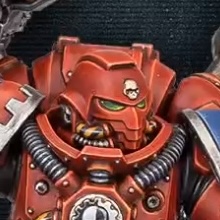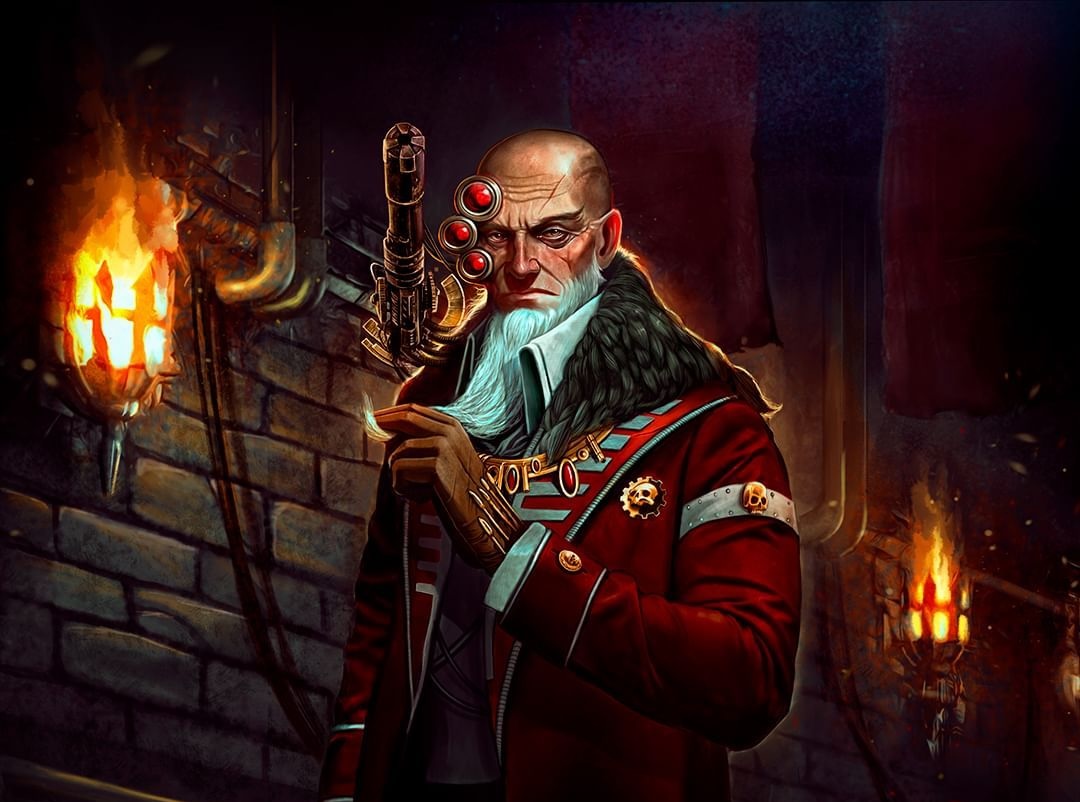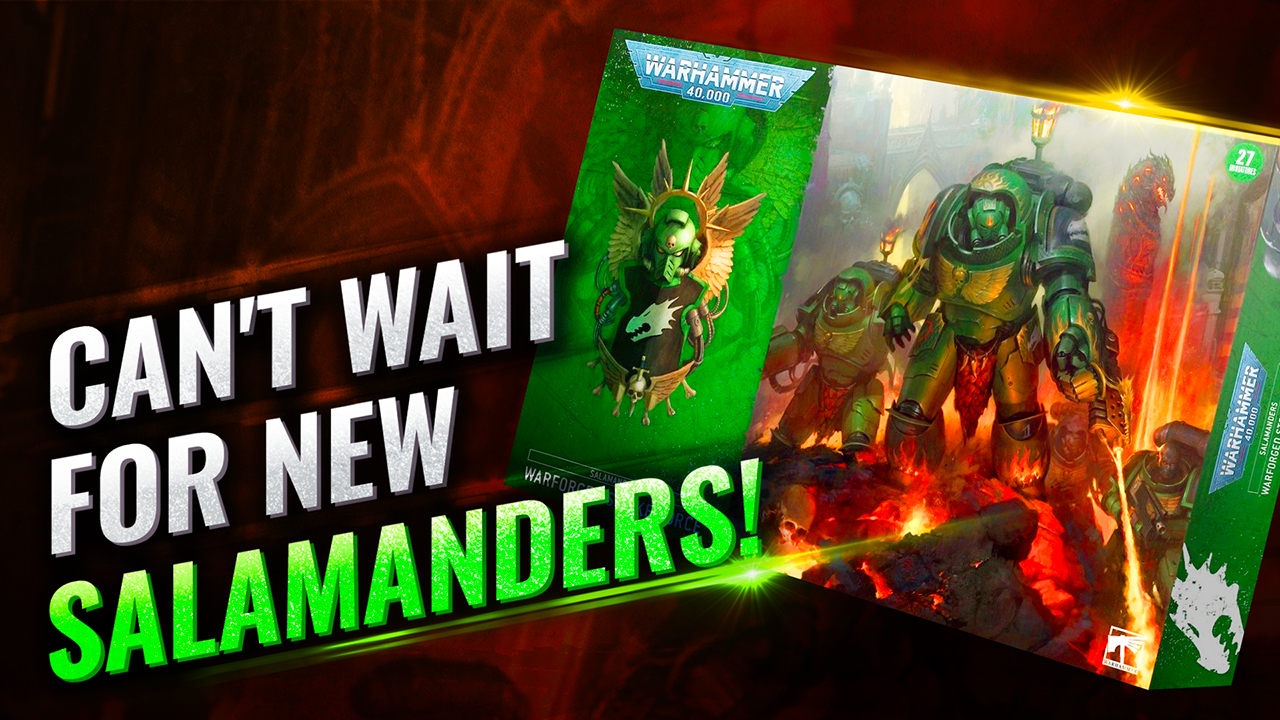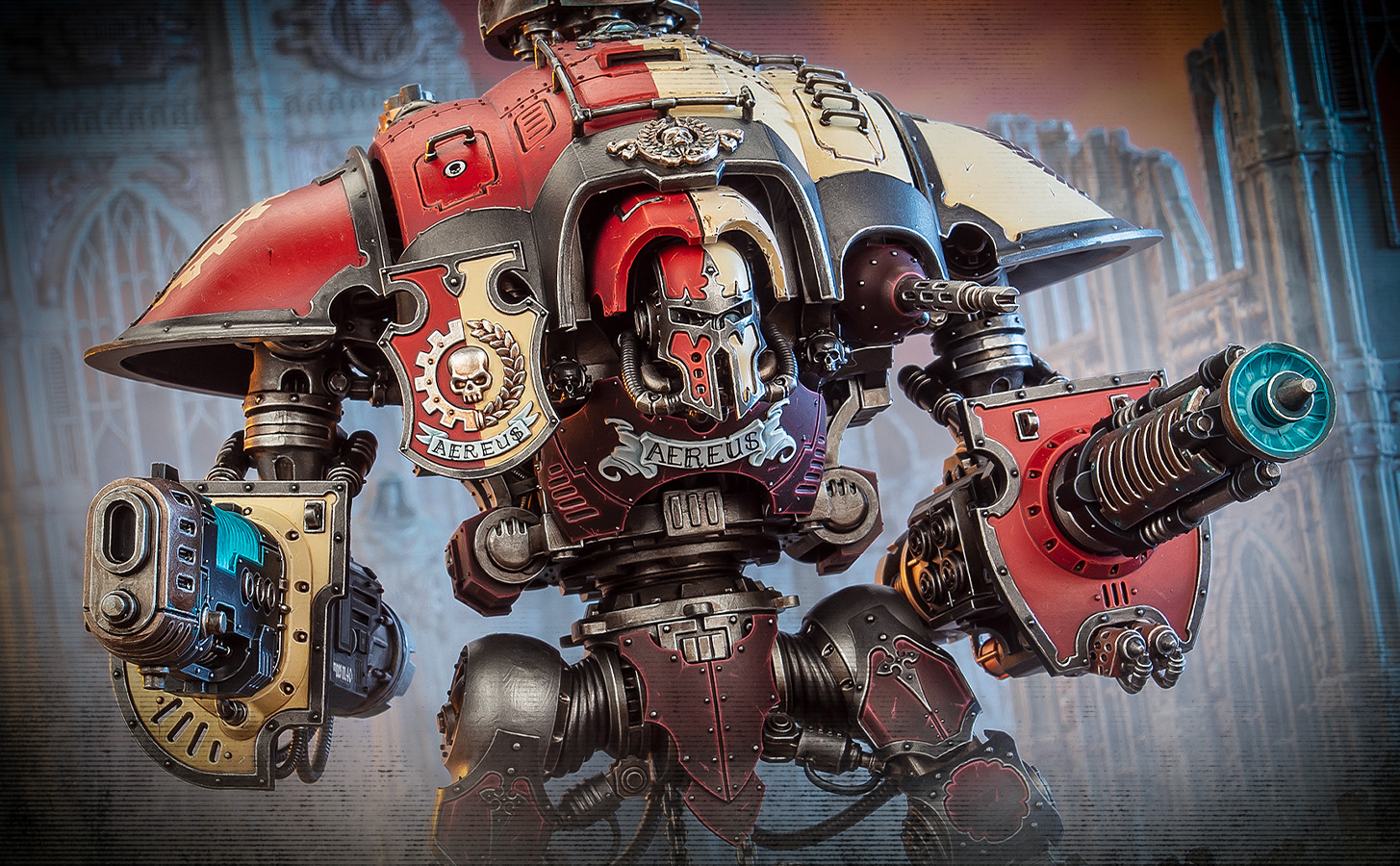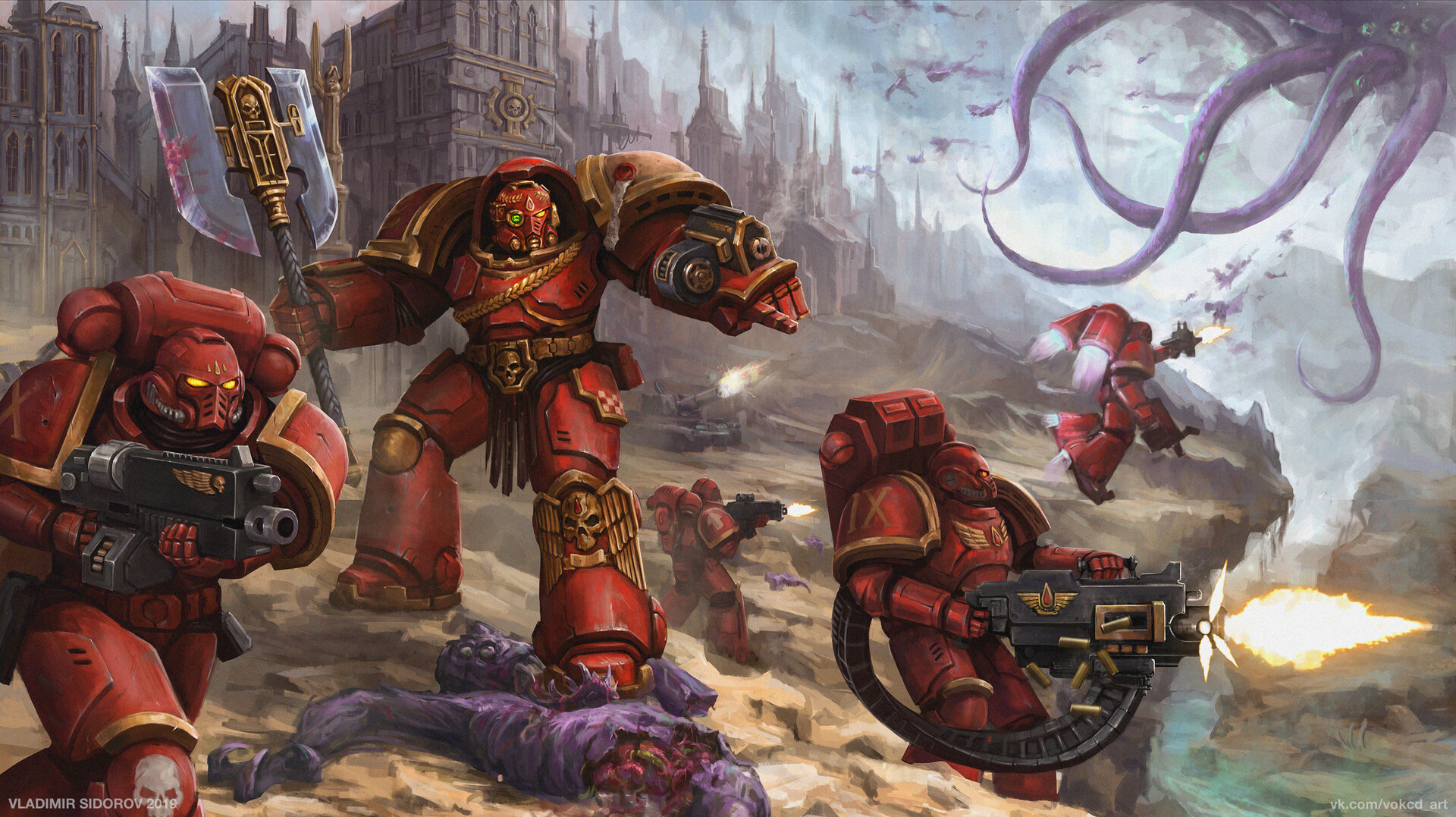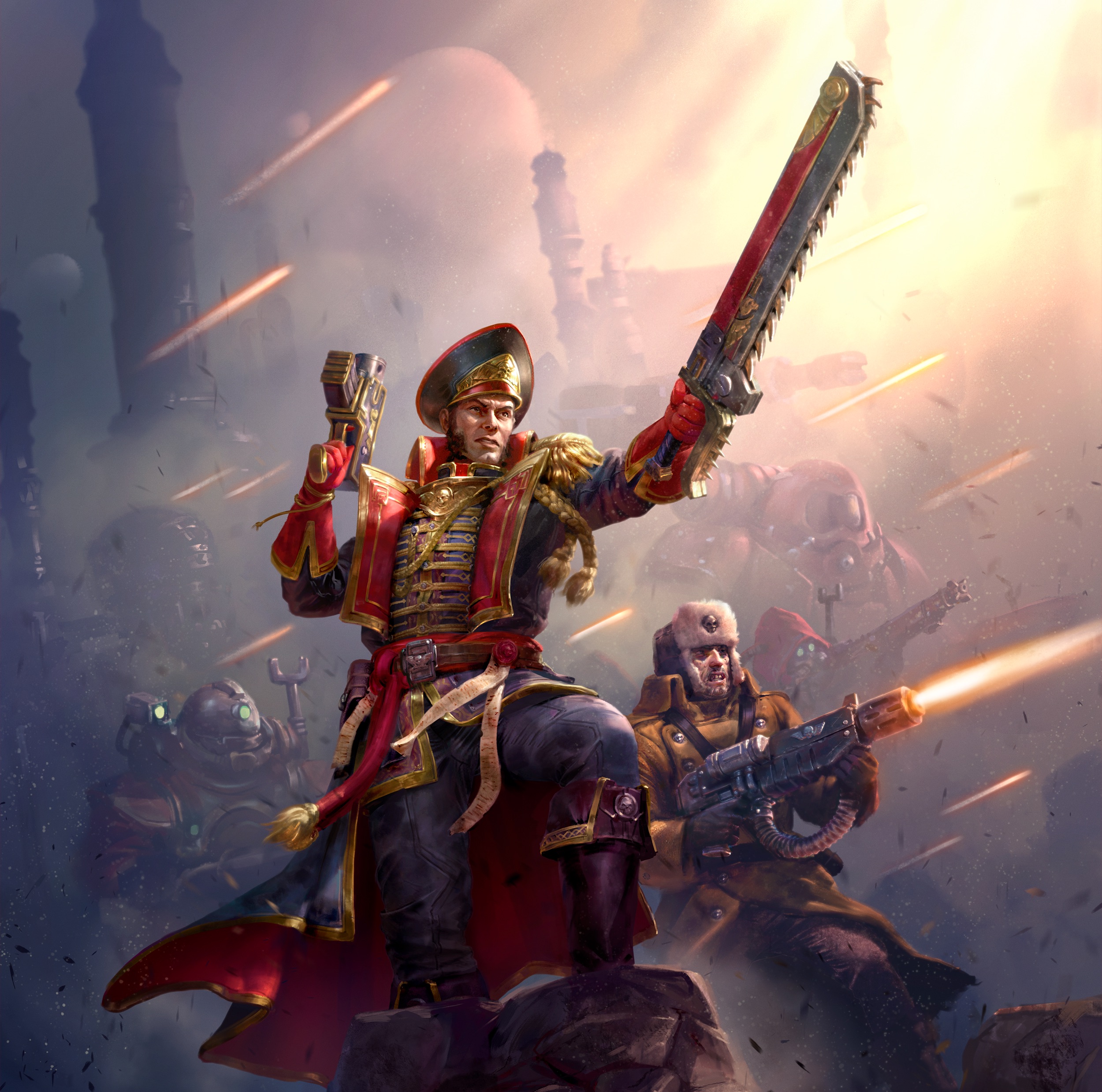Introduction to Warhammer 40,000 Box Sets
In the grim darkness of the far future, there is only war—and an impressive lineage of starter box sets that have introduced countless hobbyists to the dystopian universe of Warhammer 40,000. Since its inception in 1987, Games Workshop’s flagship science fiction wargame has evolved dramatically, with each new edition bringing refinements to rules, improvements in miniature quality, and fresh narrative developments to the sprawling lore of the 41st Millennium.
Box sets have served as the primary gateway into the Warhammer 40,000 hobby for generations of players. These carefully curated collections typically include rulebooks, dice, measuring tools, and—most importantly—the iconic miniatures that have defined the aesthetic of the game. More than mere product packages, these sets represent pivotal moments in the game’s history, often coinciding with major rule revisions, the introduction of new factions, or significant advancements in miniature design technology.
The evolution of these box sets mirrors the development of the hobby itself. From the simple plastic Space Marines of the late 1980s to the intricately detailed multi-part kits of the 2020s, each iteration has reflected the technological capabilities, design philosophies, and business strategies of Games Workshop at that particular moment in time. They serve as historical artifacts that document the progression of one of the most enduring tabletop wargames in history.
This article provides a comprehensive overview of the major Warhammer 40,000 box sets released over the past four decades. We’ll examine their contents, historical context, and significance to both the game system and the broader hobby landscape. Whether you’re a veteran player who remembers the excitement of opening your first Rogue Trader-era box, or a newcomer curious about the heritage of the game, this chronological journey through the evolution of Warhammer 40,000 starter sets offers insight into how a niche British tabletop game grew into a global phenomenon with millions of players worldwide.
Early Editions (1987-1998)
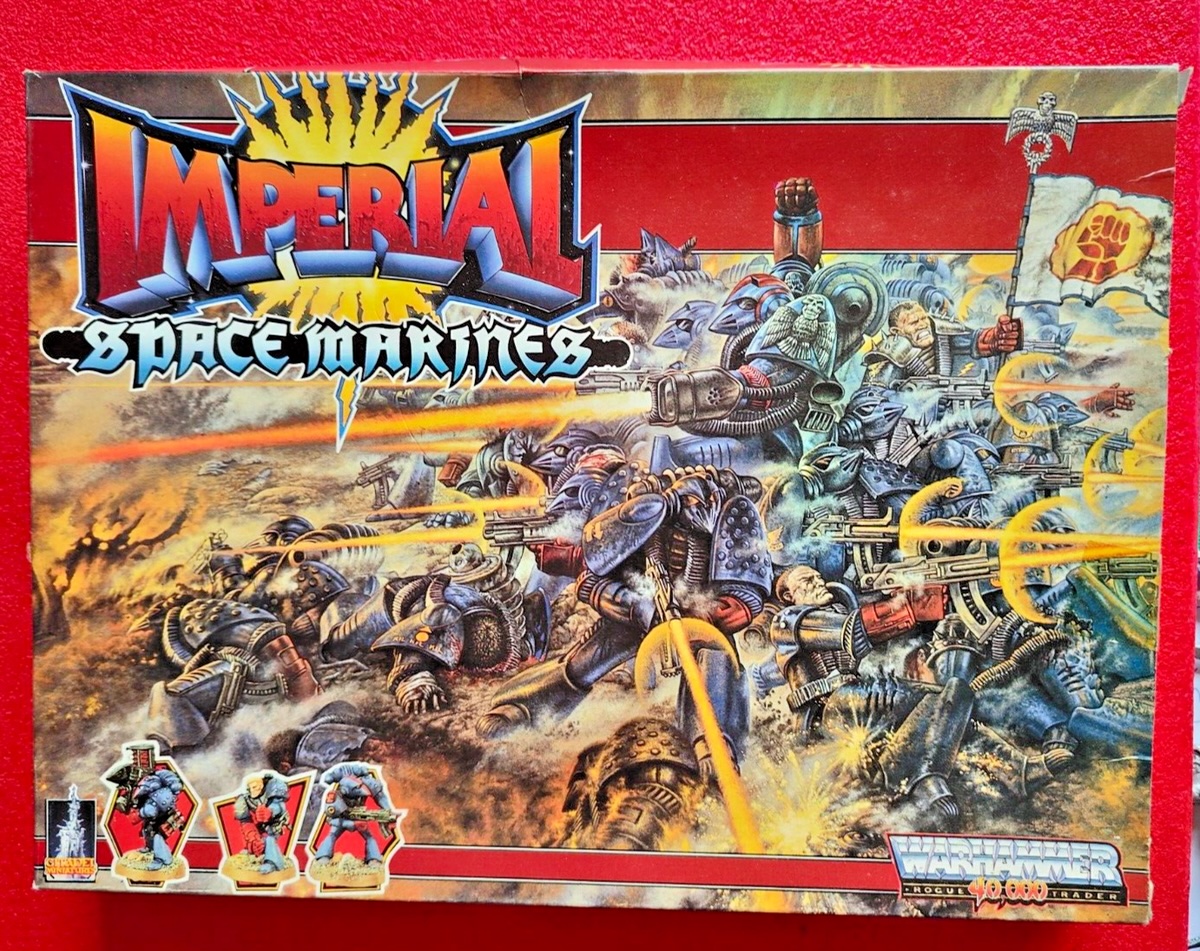
Imperial Space Marines Box Set (RTB01) - 1987
The story of Warhammer 40,000 box sets begins with the unassuming “Imperial Space Marines Box Set,” also known by its product code RTB01. Released in 1987 alongside the first edition rulebook (commonly referred to as “Rogue Trader”), this modest box represented the initial foray into what would become one of the most recognizable science fiction universes in tabletop gaming.
Unlike the comprehensive starter sets that would follow, RTB01 was not a complete game in itself but rather a supplement to the Rogue Trader rulebook. The box contained 30 plastic Space Marine miniatures—a revolutionary product at the time, as plastic miniatures were still relatively uncommon in the wargaming hobby, which had been dominated by metal figures. These early Space Marines were simple by modern standards, with limited pose options and somewhat crude details, but they established the iconic silhouette that would define the Adeptus Astartes for decades to come.
The RTB01 Space Marines featured the distinctive backpack, shoulder pads, and helmet design that remains recognizable today, though with notably less bulk than their modern counterparts. The set included options for standard bolter-armed troops, a heavy weapon (missile launcher), and a sergeant with chainsword. These multi-part plastic kits allowed for some customization—a novel concept at the time—and helped establish the hobby aspect of Warhammer 40,000 that would become central to its identity.
The historical significance of this box set cannot be overstated. It introduced the Space Marines, who would become the poster children of the Warhammer 40,000 universe and Games Workshop’s most popular and profitable faction. The relatively affordable price point and the durability of plastic (compared to the fragile metal alternatives) made this an accessible entry point for new hobbyists, helping to establish a dedicated player base during the game’s formative years.

2nd Edition Box Set - 1993
Six years after the release of Rogue Trader, Games Workshop unveiled the 2nd Edition of Warhammer 40,000, accompanied by what would become the template for all future starter sets. The 2nd Edition Box Set represented a complete reimagining of how the game was presented and played, shifting from the roleplaying-influenced framework of Rogue Trader toward a more structured wargame.
This substantial box contained everything needed to play the game: a hardback rulebook, templates, dice, range rulers, and—most importantly—two opposing forces of plastic miniatures. The included armies featured Space Marines (20 models) and Orks (20 models), establishing the pattern of “Imperium versus antagonist” that would characterize most future box sets. The miniatures represented a significant advancement in plastic molding technology, with more dynamic poses and finer details than their RTB01 predecessors.
The 2nd Edition rulebook was a lavishly illustrated hardcover volume that expanded the lore of the 41st Millennium, cementing many of the thematic elements that would define the setting: the God-Emperor on the Golden Throne, the constant warfare across the galaxy, and the religious fanaticism of the Imperium. The rules themselves were more complex than modern iterations, with detailed psychic phases, complex vehicle damage charts, and numerous special abilities.
Beyond its contents, the 2nd Edition Box Set is notable for its striking artwork and presentation. The box cover featured a Space Marine in combat with an Ork, rendered in a distinctive painted style that would define the aesthetic of this era. This visual approach, combined with the gothic and baroque elements introduced in the artwork and miniature design, established the unique visual identity of Warhammer 40,000 that distinguished it from other science fiction settings.
The 2nd Edition era saw Games Workshop expand its retail presence significantly, and this box set served as the flagship product that introduced many new players to the hobby. Its comprehensive nature—providing everything needed to play substantial games right out of the box—set the standard for what consumers would expect from a Warhammer 40,000 starter set for decades to come.
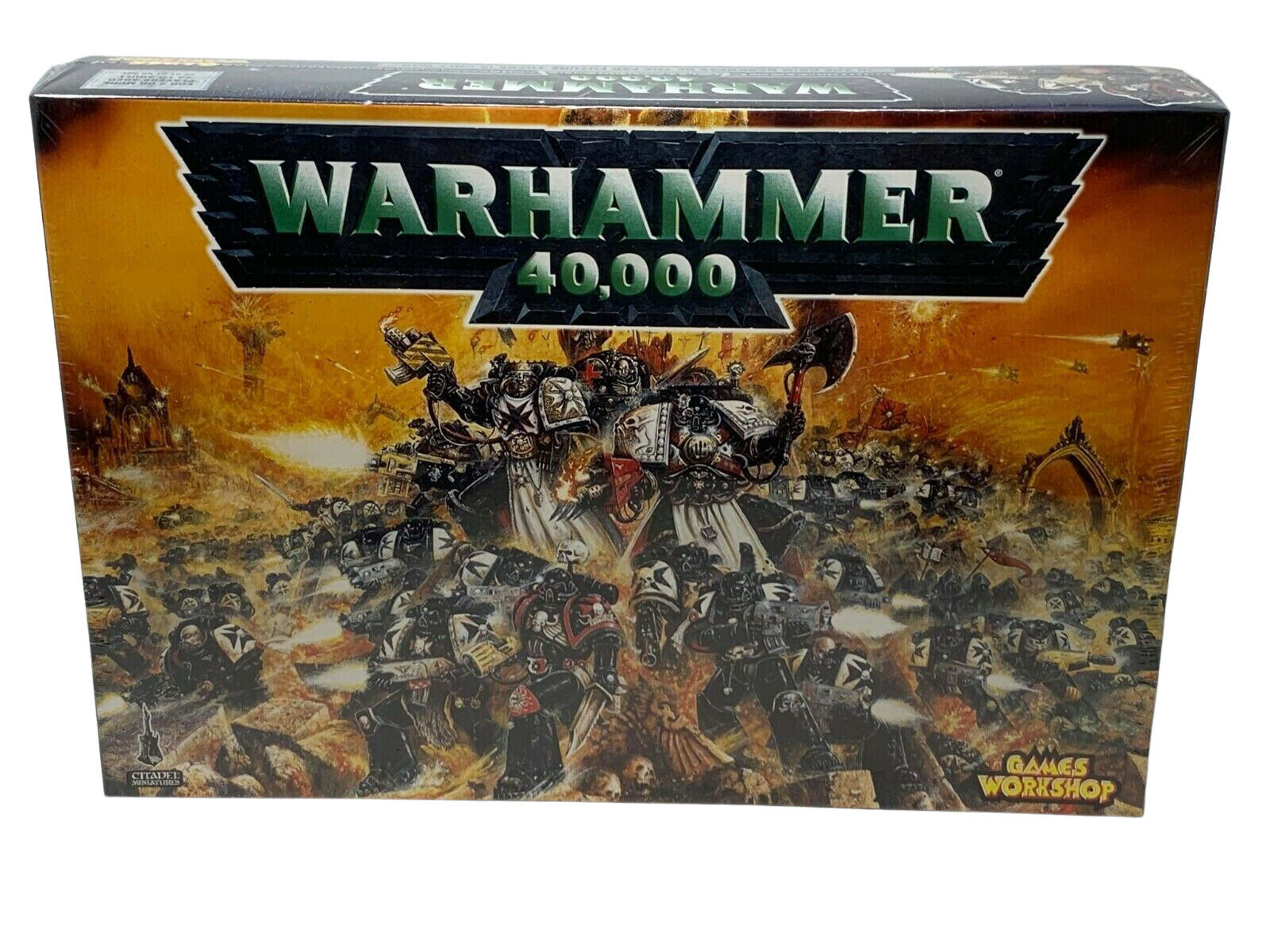
3rd Edition Box Set - 1998
By the late 1990s, Warhammer 40,000 had grown considerably in complexity, with numerous expansions and supplements adding layers of rules to the 2nd Edition framework. The 3rd Edition Box Set, released in 1998, represented a dramatic streamlining of the game system, making it more accessible to newcomers while maintaining depth for veteran players.
This box set introduced players to the Dark Eldar, a new faction making their debut as the antagonists facing off against the ever-present Space Marines. This marked an important expansion of the game’s universe, moving beyond the Ork antagonists that had featured prominently in previous marketing. The Dark Eldar brought a new aesthetic to the game—sleek, sinister, and distinctly alien compared to the bulky, gothic design of the Space Marines.
The contents of the 3rd Edition Box Set included a softback rulebook, templates, dice, and two forces: Space Marines (consisting of tactical marines and a sergeant and a Landspeeder) and Dark Eldar (Kabalite warriors). The miniatures showed continued improvement in plastic molding technology, with more detailed sculpts and complex components. Notably, this set introduced the 25mm round base for infantry that would become standard for many years.
The 3rd Edition rules represented perhaps the most significant overhaul in the game’s history. The complex charts and numerous exceptions of 2nd Edition were replaced with a streamlined “core rules plus exceptions” model that would form the foundation of all subsequent editions. Vehicle rules were simplified, army construction was standardized through the introduction of the Force Organization Chart, and the psychic phase was dramatically reduced in complexity.
This box set arrived at a pivotal moment for Games Workshop, as the company was expanding internationally and establishing its own network of dedicated retail stores. The simplified ruleset made the game more approachable for the growing audience, while the striking new Dark Eldar faction demonstrated that the Warhammer 40,000 universe extended far beyond the iconic Space Marines.
The 3rd Edition Box Set’s legacy is primarily in its rules overhaul, which established the fundamental mechanics that would evolve into modern Warhammer 40,000. Many players who joined the hobby during this period remain active today, making this box set a nostalgic touchstone for a significant portion of the community. The Dark Eldar, while initially popular, would not appear in another starter set for many years, making this box somewhat unique in the game’s history.
Middle Editions (2004-2014)

Battle for Macragge (4th Edition) - 2004
The dawn of the new millennium brought significant changes to Games Workshop’s approach to Warhammer 40,000, and the Battle for Macragge box set embodied this evolution. Released in 2004 to launch the 4th Edition ruleset, this starter set introduced a stronger narrative focus that would become increasingly important to the game’s identity.
As the name suggests, Battle for Macragge centered on the conflict between the Ultramarines Chapter of Space Marines and Tyranid invaders on the Ultramarines’ home world. This narrative focus was a departure from previous box sets, which had presented more generic confrontations. By tying the starter set to a specific battle from the game’s lore, Games Workshop began more explicitly connecting the tabletop experience to the rich background narrative that had been developing through novels, codexes, and other supplementary materials.
The contents of the Battle for Macragge set included a digest-sized rulebook, templates, dice, and terrain pieces representing a crashed Imperial shuttle. The miniatures continued the tradition of pitting Space Marines against a xenos threat, with the box containing 10 Space Marines, an Imperial pilot, 10 Tyranid Termagants, 8 Spore Mines, and 6 Genestealers. The Tyranids represented another significant alien faction entering the starter set lineup, bringing their distinctive organic, insectoid aesthetic to contrast with the technological might of the Space Marines.
The 4th Edition rules built upon the foundation established in 3rd Edition, refining rather than revolutionizing the game system. Combat mechanics were streamlined, and the vehicle damage system was adjusted to make armored units more resilient on the battlefield. The digest-sized rulebook made the core rules more accessible, while a separate “Getting Started” book provided scenarios specifically designed to introduce new players to the game mechanics gradually.
Battle for Macragge also introduced more substantial terrain elements than previous starter sets, with the crashed shuttle providing a focal point for the included scenarios. This emphasis on narrative play and terrain would become increasingly important in future editions of the game.
Priced at £40 in the UK market, Battle for Macragge maintained the relatively accessible price point that had helped Warhammer 40,000 continue its growth. The set’s focus on the Ultramarines—specifically identified by their distinctive blue color scheme in all marketing materials—further cemented their position as the poster boys of the Warhammer 40,000 universe, a status they retain to this day.
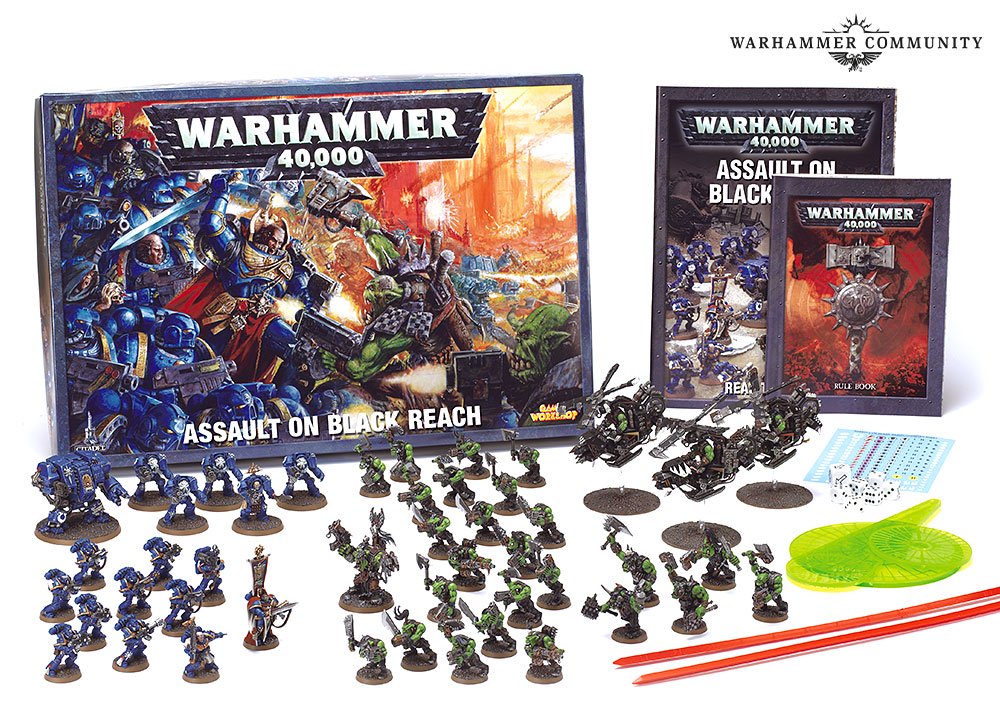
Assault on Black Reach (5th Edition) - 2008
Four years after Battle for Macragge, Games Workshop released Assault on Black Reach alongside the 5th Edition ruleset. This box set returned to the Space Marines versus Orks matchup that had featured in the 2nd Edition starter, but with dramatically improved miniature quality and a continued emphasis on narrative context.
Assault on Black Reach depicted a conflict between the Ultramarines and Ork forces led by Warboss Zanzag during a Waaagh! invasion of the Imperial world of Black Reach. The narrative elements were integrated into the included “Getting Started” book, which featured three scenarios designed to gradually introduce players to the game’s mechanics.
The miniature content of this box set was particularly generous, offering significant value for its £50 price point. The Space Marine contingent included a Captain, 5 Terminators, a Dreadnought, and 10 Tactical Marines. The Ork forces were even more numerous, with a Warboss, 5 Nobz, 20 Ork Boyz, and 3 Deffkoptas. These push-fit models represented a new approach to starter set miniatures—they required no glue for assembly, making them more accessible to newcomers, yet maintained a level of detail that made them viable additions to existing collections.
The 5th Edition rulebook included in the set (again in digest format) refined the game further, with significant changes to cover rules, vehicle damage, and true line-of-sight for determining visibility. The ruleset was generally well-received for balancing complexity and playability, and many veterans consider 5th Edition to be one of the most balanced iterations of the game.
Assault on Black Reach is notable for its influence beyond the starter set itself. The Captain miniature became particularly iconic and was repurposed in numerous other products. The push-fit technology pioneered in this set would become standard for starter set miniatures going forward, allowing for easier entry into the hobby while maintaining aesthetic appeal.
The set’s release coincided with a period of significant growth for Games Workshop, with expanding international presence and increasing mainstream recognition of the Warhammer 40,000 intellectual property through novels, video games, and other media. Assault on Black Reach served as the entry point for many players who remain active in the hobby today, giving it a special place in the community’s collective memory.

Dark Vengeance (6th & 7th Editions) - 2012
Dark Vengeance marked a significant departure from previous starter sets in several ways. Released in 2012 for the 6th Edition of Warhammer 40,000, it was the first box set to feature the Dark Angels Chapter of Space Marines rather than the Ultramarines, and it pitted them against Chaos Space Marines from the Crimson Slaughter warband. This shift to an “Imperium versus Chaos” narrative would influence many future box sets.
Unusually for a Warhammer 40,000 starter set, Dark Vengeance remained the primary starter box when 7th Edition was released in 2014, serving across two edition cycles. This longevity speaks to both the quality of the included miniatures and Games Workshop’s changing approach to product releases during this period.
The contents of Dark Vengeance showcased a new level of detail and complexity in plastic miniatures. The Dark Angels force included a Company Master, a Librarian, a Tactical Squad, a Deathwing Terminator Squad, and a Ravenwing Bike Squadron. The Chaos contingent featured a Chaos Lord, Helbrute (a new designation for Chaos Dreadnoughts), Chosen Chaos Space Marines, and two units of Cultists. The initial wave of Dark Vengeance sets also included a limited edition Interrogator-Chaplain Seraphicus miniature, which became a sought-after collector’s item.
These miniatures represented a significant advancement in plastic molding technology, with unprecedented levels of detail for push-fit models. Many of the character models in particular featured intricate designs that would previously have been possible only in metal or resin. The Chaos Cultists were especially notable as they introduced an entirely new unit type to the Chaos Space Marine faction.
The 6th Edition rules included in Dark Vengeance introduced the “Allies” system, allowing different factions to fight together, as well as expanded rules for flyers and fortifications. When 7th Edition was released in 2014, the core Dark Vengeance set remained the same, but with an updated rulebook.
Dark Vengeance is also notable for its expanded media tie-ins. A novella by C.Z. Dunn, also titled “Dark Vengeance,” was released alongside the set, along with audio dramas and other supplementary materials that expanded on the conflict between the Dark Angels and Crimson Slaughter. This multimedia approach reflected Games Workshop’s increasing sophistication in building narrative frameworks around their product releases.
The Dark Vengeance box set, with its gothic aesthetic and Imperium versus Chaos theme, embodied the grimdark atmosphere that had become synonymous with Warhammer 40,000. Its success demonstrated that starter sets could move beyond the traditional Ultramarines focus while still appealing to both new and veteran players.
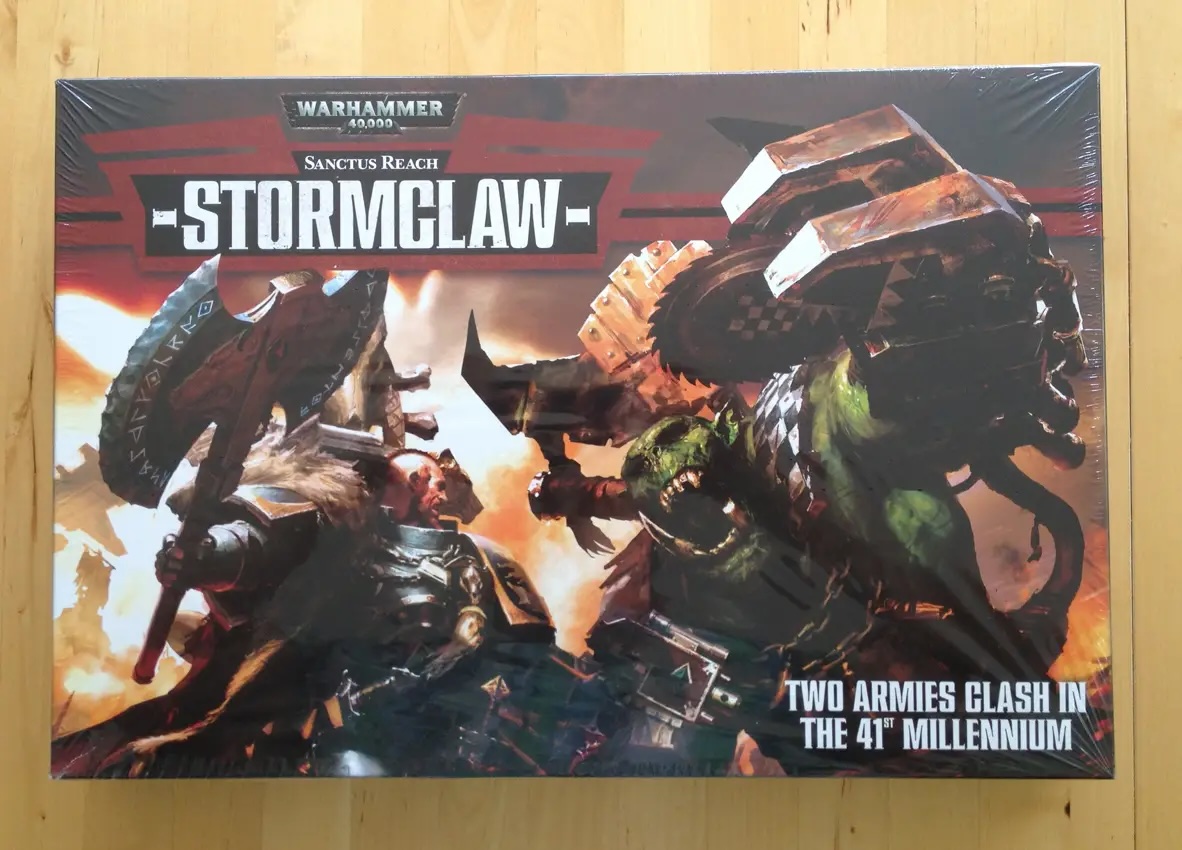
Stormclaw (7th Edition) - 2014
While Dark Vengeance continued to serve as the primary starter set for 7th Edition, Games Workshop supplemented it with additional battlebox releases, the most significant of which was Stormclaw in 2014. This box set represented a new product category for Warhammer 40,000—not a complete starter set with the full rulebook, but a “battlebox” focused on a specific conflict with a campaign supplement and selected forces.
Stormclaw featured a confrontation between the Space Wolves Chapter of Space Marines and Ork forces during the “Red Waaagh!” campaign. This narrative focus continued the trend of anchoring box sets in specific events within the game’s universe, providing context for the included forces and scenarios.
The contents of Stormclaw included a softback rulebook, a campaign supplement titled “Sanctus Reach: Stormclaw,” and two substantial forces. The Space Wolves contingent featured the character Krom Dragongaze, 5 Wolf Guard Terminators, 5 Grey Hunters, and 5 Blood Claws. The Ork forces included the new character Grukk Face-rippa, 5 Nobz, 10 Gretchin with a Runtherd, and 3 Killa Kans. These miniatures continued the high standard of detail established in Dark Vengeance, with character models that were particularly impressive.
The 7th Edition rules represented the culmination of the rules development that had begun with 3rd Edition. The system had grown increasingly complex, with numerous special rules, formations, and supplements. This complexity provided depth for experienced players but created a steeper learning curve for newcomers—a tension that would eventually lead to the dramatic overhaul seen in 8th Edition.
Stormclaw’s position as a supplementary box rather than the main starter set reflected Games Workshop’s evolving business strategy during this period. The company began releasing more frequent, focused box sets tied to specific narrative campaigns, allowing players to expand their collections around thematic elements rather than just faction considerations.
The Space Wolves upgrade sprue included in Stormclaw was particularly notable, as it allowed for the creation of distinctively Viking-inspired Space Marines with unique decorative elements. This approach to faction-specific detailing would become increasingly important in future releases.
Stormclaw, released at £95, represented a higher price point than traditional starter sets, reflecting both the quality of the included miniatures and Games Workshop’s premium positioning in the market. Despite this higher price, the set was well-received for its value proposition and the unique miniatures it contained, particularly the character models that were exclusive to this release.
Recent Editions (2017-2023)

Dark Imperium (8th Edition) - 2017
The release of Dark Imperium in 2017 marked one of the most significant turning points in Warhammer 40,000’s history. This box set launched the 8th Edition of the game, which represented the most dramatic rules overhaul since the transition from 2nd to 3rd Edition nearly two decades earlier. More importantly, it introduced the Primaris Space Marines—a new generation of genetically enhanced warriors that would fundamentally change the Imperium’s most iconic faction.
Dark Imperium’s narrative was set against the backdrop of the Indomitus Crusade, following the catastrophic events of the Gathering Storm campaign that had concluded 7th Edition. The resurrection of the Primarch Roboute Guilliman and the introduction of his new Primaris Space Marines represented a major advancement in the game’s storyline, moving the timeline forward significantly for the first time in many years.
The contents of the box reflected this narrative shift, featuring an impressive array of new Primaris Space Marine units facing off against the Death Guard—a Chaos Space Marine faction dedicated to the plague god Nurgle, receiving their first major update in decades. The Primaris contingent included a Captain in Gravis armor, two Lieutenants, an Ancient (standard bearer), two squads of Intercessors, a squad of Hellblasters, and a squad of Inceptors. The Death Guard force featured a Lord of Contagion, a Malignant Plaguecaster, a Noxious Blightbringer, a unit of Plague Marines, a Foetid Bloat-drone, and twenty Poxwalkers.
These miniatures represented another quantum leap in plastic molding technology, with unprecedented levels of detail and complexity. The Death Guard models in particular showcased a new level of grotesque intricacy, with buboes, tentacles, and other corrupted features rendered in stomach-churning detail. The Primaris Space Marines established a new aesthetic for the Adeptus Astartes—taller, more proportionally realistic, and with more streamlined armor than their “firstborn” predecessors.
The 8th Edition rulebook included in Dark Imperium introduced a dramatically simplified core ruleset, addressing the complexity issues that had accumulated through previous editions. The 12-page core rules were even made available as a free download—an unprecedented move that reflected Games Workshop’s new approach to accessibility. The full rulebook expanded on these core concepts with advanced rules, narrative play options, and extensive background material on the new state of the galaxy following the Great Rift’s appearance.
Priced at £95/$160, Dark Imperium represented a premium product, but the quantity and quality of the included miniatures made it an attractive value proposition. The set was supplemented by two smaller starter sets—”Know No Fear” and “First Strike”—at lower price points, creating a tiered entry system that allowed new players to join the hobby at different investment levels.
The introduction of Primaris Space Marines through Dark Imperium proved somewhat controversial among veteran players, with some viewing it as an unnecessary replacement for the classic Space Marine range. However, the commercial success of the box set and subsequent Primaris releases confirmed Games Workshop’s strategy, and Primaris Marines quickly became the new standard bearers for the Warhammer 40,000 range.
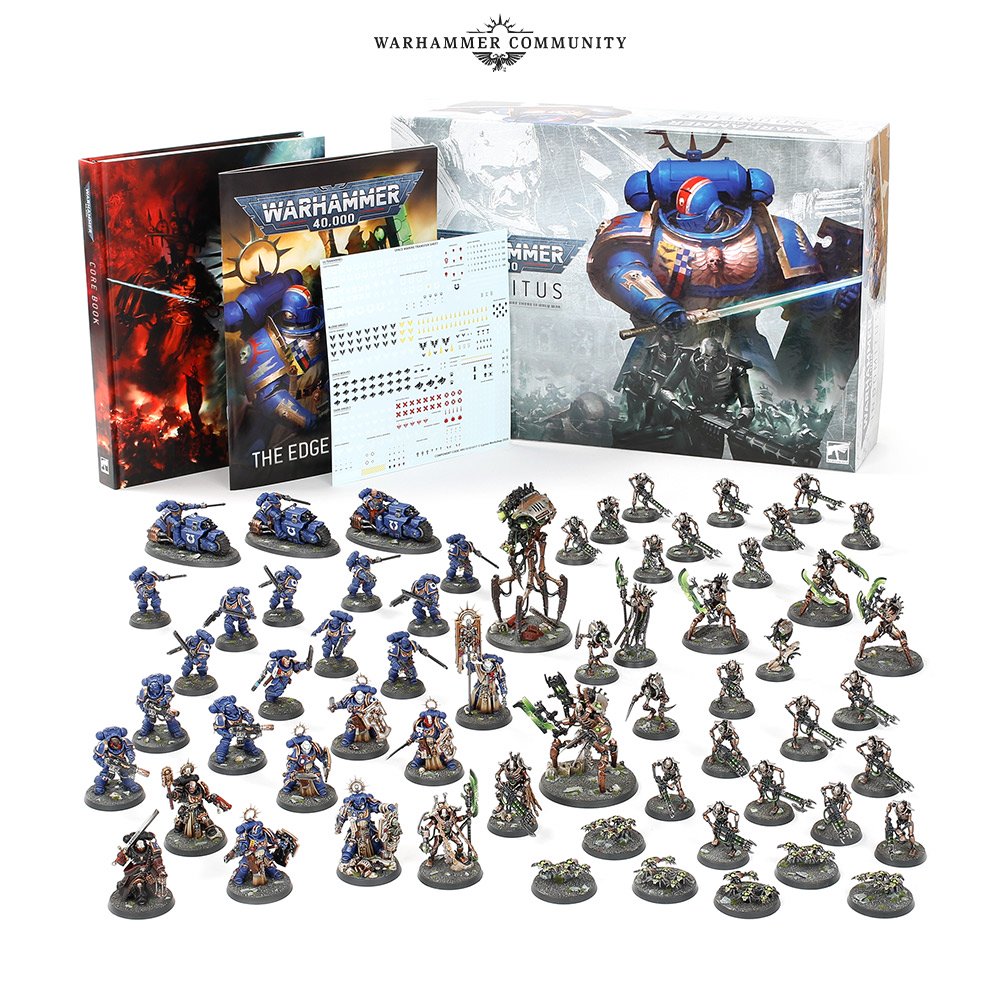
Indomitus (9th Edition) - 2020
Released in July 2020 during the global COVID-19 pandemic, Indomitus launched the 9th Edition of Warhammer 40,000 and continued the narrative of the Indomitus Crusade. Unlike previous edition transitions, the shift from 8th to 9th Edition represented refinement rather than revolution, building on the successful foundation established in 2017.
Indomitus was marketed as a limited-run box set rather than an ongoing starter set, creating unprecedented demand that saw the initial allocation sell out during pre-orders within minutes. Games Workshop subsequently made the set available through a made-to-order period to accommodate the unexpected level of interest.
The box contained two substantial forces: a Space Marine contingent and a Necron force, reviving the Imperium versus xenos dynamic of many previous starter sets. The Space Marine models included a Captain with relic shield, a Lieutenant, a Chaplain, a Judiciar (a new unit type), Assault Intercessors (another new unit), Bladeguard Veterans, Eradicators, Outriders, and a Bladeguard Ancient. The Necron force was equally impressive, featuring an Overlord, Royal Warden, Plasmancer, Skorpekh Lord, Skorpekh Destroyers, Cryptothralls, a Canoptek Reanimator, Warriors, and Scarab Swarms.
These miniatures represented yet another advancement in design and detail, particularly for the Necrons, who received their most significant range refresh since their introduction to the game. The new Necron aesthetic moved away from the somewhat static poses of earlier iterations toward more dynamic, threatening stances, with new weapon designs and more varied unit types.
The 9th Edition rulebook included in Indomitus refined the streamlined approach of 8th Edition while addressing balance issues and competitive play concerns. The core mechanics remained largely unchanged, but adjustments to command points, terrain rules, and strategic reserves created a more tactically nuanced game. The rulebook also included extensive narrative material about the Pariah Nexus—a region of space where the Necrons were implementing technology to sever the connection between realspace and the Warp.
In addition to the main rulebook, Indomitus included “Edge of Silence,” a supplementary booklet containing datasheets for all included units and narrative missions specific to the box set’s contents. This approach of including tailored scenarios would continue in subsequent box sets, enhancing the narrative play experience straight out of the box.
Priced at £125/$199, Indomitus represented significant value given the number and quality of included miniatures—so much so that many purchasers bought the set primarily for the models rather than as an entry point to the game. Following the limited release of Indomitus, Games Workshop introduced a series of smaller starter sets at various price points to serve as ongoing entry products for 9th Edition.
The success of Indomitus demonstrated the growing popularity of Warhammer 40,000 even amid global challenges, with the hobby providing an engaging pastime during lockdown periods. The set’s limited nature also reflected Games Workshop’s increasing use of FOMO (fear of missing out) marketing strategies, creating urgency around new releases.
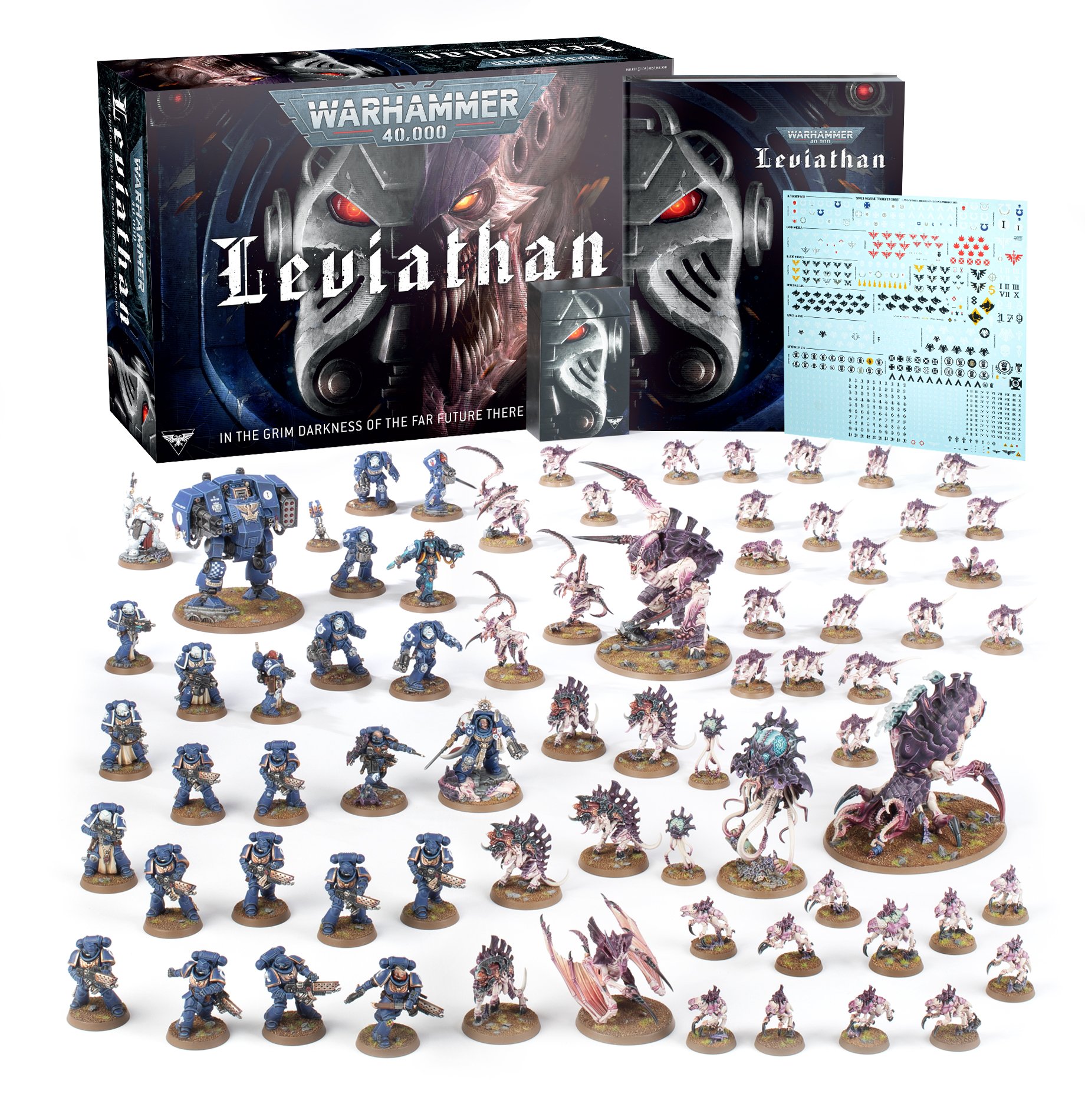
Leviathan (10th Edition) - 2023
The most recent major box set as of this writing, Leviathan launched the 10th Edition of Warhammer 40,000 in June 2023. This release continued the pattern established with Indomitus—a premium, limited-run box set containing two substantial forces and the core rulebook for the new edition.
Leviathan’s narrative centered on the Fourth Tyrannic War, returning to the Tyranids as antagonists for the first time since Battle for Macragge nearly two decades earlier. This thematic callback was reinforced by the inclusion of Space Marine Terminators, which had been somewhat overshadowed by Primaris releases in recent years but returned to prominence in this set.
The contents of Leviathan were particularly generous, with 72 miniatures divided between Space Marines and Tyranids. The Space Marine force included a Captain in Terminator Armor, a Lieutenant with combi-weapon, a Librarian in Terminator Armor, an Apothecary Biologis, a squad of Terminators, Sternguard Veterans, Infernus Marines (a new unit type), and a Ballistus Dreadnought. The Tyranid contingent featured a Tyranid Prime, a Neurotyrant with Neuroloids, a Screamer-Killer, a Psychophage, Von Ryan’s Leapers, Barbgaunts, Neurogaunts, Termagants, and Ripper Swarms.
These miniatures showcased continued evolution in design philosophy, with the new Tyranid units in particular featuring more dynamic poses and detailed anatomy than previous iterations. The Space Marine models balanced nostalgia for classic unit types like Terminators with new design elements that kept them visually consistent with the modern range.
The 10th Edition rulebook included in Leviathan represented another refinement rather than revolution, streamlining certain mechanics while maintaining the core gameplay established in 8th Edition. Notable changes included a revised detachment system, adjustments to stratagems, and updated terrain rules. The special edition rulebook in Leviathan combined the core rules with “Crusade: Tyrannic War,” a campaign supplement that was later sold separately.
In addition to the rulebook and miniatures, Leviathan included a 66-card Chapter Approved Mission Deck, providing ready-to-play scenarios that showcased the new edition’s mechanics. This component reflected Games Workshop’s increasing use of cards and other supplementary materials to enhance the gaming experience beyond the traditional dice and measuring tools.
Priced at £150/$240, Leviathan continued the premium positioning of limited-run launch boxes. As with Indomitus, the set sold out quickly during pre-orders, though Games Workshop had prepared for high demand with increased production. Following Leviathan’s limited release, a series of smaller starter sets was introduced to serve as ongoing entry points for new players.
The Leviathan box set demonstrated Games Workshop’s confidence in the Warhammer 40,000 brand, with its premium pricing and extensive contents reflecting the company’s understanding of its core audience’s willingness to invest in high-quality products. The return to Tyranids as antagonists also showed an awareness of the game’s heritage, creating a sense of narrative continuity across the decades of the game’s evolution.
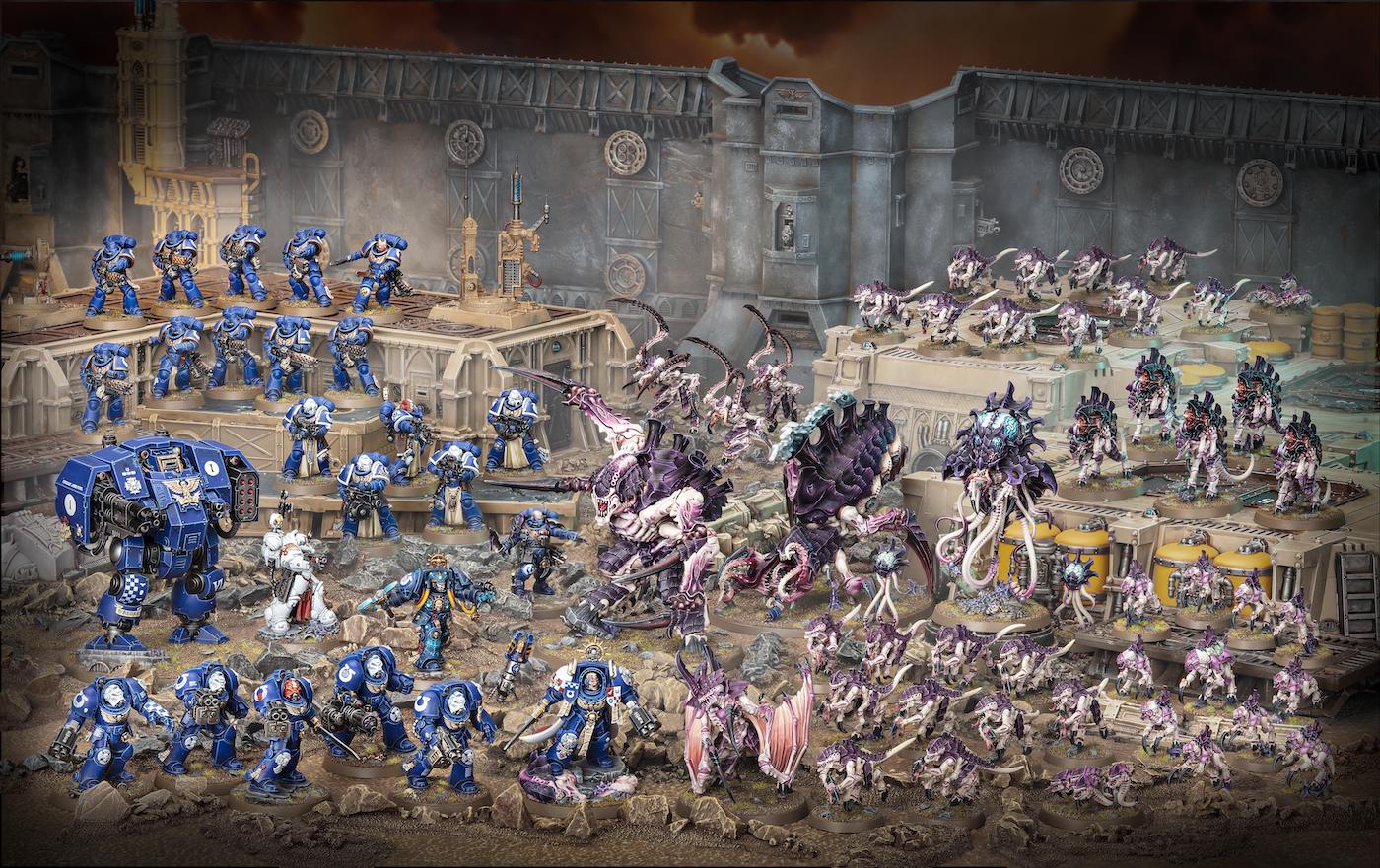
Evolution and Trends
Throughout the four decades of Warhammer 40,000 box sets, several clear trends emerge that reflect not only the evolution of the game itself but also broader shifts in the tabletop gaming industry, manufacturing technology, and Games Workshop’s business strategy.
Miniature Quality and Design
Perhaps the most visually obvious progression has been in the quality and complexity of the included miniatures. The simple, somewhat crude plastic Space Marines of the RTB01 box bear little resemblance to the intricately detailed Primaris Marines of recent sets. This evolution reflects advancements in plastic injection molding technology, with modern kits featuring details that would have been impossible to produce in the 1980s and 1990s.
The design philosophy has also shifted significantly. Early miniatures were functional gaming pieces with limited pose options and somewhat exaggerated proportions. Modern Warhammer 40,000 miniatures are highly detailed collectible models in their own right, with dynamic poses, realistic proportions, and numerous customization options. This shift reflects the growing importance of the hobby aspect of Warhammer 40,000, with painting and collecting becoming increasingly significant motivations for many participants alongside gameplay.
The assembly method has evolved as well. The earliest sets required glue and often significant modeling skill, while modern starter sets typically feature push-fit models that can be assembled without adhesives. This change makes the hobby more accessible to newcomers while still providing satisfying results.
Price Point and Value Proposition
The price trajectory of Warhammer 40,000 box sets tells an interesting story about the game’s market positioning. The RTB01 Space Marines box was an affordable entry point, while the 2nd Edition Box Set represented a more substantial investment but provided a complete game experience. Through the 2000s, sets like Battle for Macragge (£40) and Assault on Black Reach (£50) maintained relatively accessible price points.
A significant shift occurred with Dark Imperium (£95) and subsequent sets like Indomitus (£125) and Leviathan (£150), which positioned the main launch boxes as premium products. This pricing strategy has been balanced by the introduction of tiered starter sets at lower price points following the initial limited-run releases, creating multiple entry points for new players with different budget constraints.
Despite rising prices, the value proposition of these sets has generally been maintained or even improved, with modern boxes containing substantially more plastic (by weight and sprue count) than their predecessors. The limited-run nature of recent launch boxes has also created secondary market value, with sets like Indomitus appreciating significantly after their initial release.
Narrative Integration
The earliest Warhammer 40,000 box sets were primarily focused on providing gaming materials, with limited narrative context. Beginning with Battle for Macragge, a clear trend emerged toward integrating box sets into the broader storyline of the Warhammer 40,000 universe. Modern sets like Dark Imperium, Indomitus, and Leviathan are explicitly tied to major narrative developments, with the included forces representing specific factions engaged in conflicts that advance the overall storyline.
This narrative integration extends beyond the box contents to supplementary materials like novels, campaign books, and digital content. The launch of a new edition is now typically accompanied by a coordinated multimedia campaign that establishes the narrative context for the new ruleset and models.
Rules Complexity Cycle
The evolution of Warhammer 40,000 rules across these box sets reveals an interesting cyclical pattern. The game began with the relatively complex and open-ended Rogue Trader ruleset, was streamlined significantly with 3rd Edition, then gradually accumulated complexity through 4th, 5th, 6th, and 7th Editions. The 8th Edition launch with Dark Imperium represented another major simplification, with subsequent editions making more incremental refinements.
This pattern reflects Games Workshop’s ongoing challenge of balancing accessibility for newcomers with depth for veteran players. The company appears to have settled on a model of maintaining relatively streamlined core rules while adding complexity through faction-specific abilities, stratagems, and supplementary systems.
Target Audience and Marketing
The presentation and contents of these box sets reveal an evolving understanding of the Warhammer 40,000 audience. Early sets assumed a significant crossover with historical wargaming and emphasized the game aspects over the collecting and painting hobby. Modern sets recognize the diverse motivations of participants, with equal emphasis placed on the gaming experience, narrative immersion, and hobby aspects.
Marketing strategies have evolved from the mail-order and specialist retail approach of the 1980s and 1990s to sophisticated multimedia campaigns utilizing social media, streaming content, and limited-release strategies to generate excitement and urgency. The success of recent limited-run boxes demonstrates the effectiveness of these approaches in mobilizing the existing community while still attracting newcomers.
Faction Representation
Space Marines have featured in every major box set throughout the game’s history, reflecting their position as the flagship faction of Warhammer 40,000. The antagonist forces have been more varied, with Orks appearing in multiple sets (2nd Edition, Assault on Black Reach, Stormclaw), Tyranids featuring twice (Battle for Macragge, Leviathan), and other xenos races like Dark Eldar (3rd Edition) and Necrons (Indomitus) making single appearances. Chaos forces have appeared in two major sets (Dark Vengeance, Dark Imperium).
This pattern reflects both the commercial reality of Space Marines’ popularity and the narrative structure of the setting, where the Imperium of Man serves as the central human perspective in a hostile universe. The rotation of antagonist forces allows Games Workshop to refresh different factions periodically while maintaining the familiar entry point of Space Marines for new players.
Conclusion
The evolution of Warhammer 40,000 box sets over nearly four decades tells a story of remarkable growth and transformation. What began as a niche science fiction offshoot of fantasy wargaming has developed into one of the most recognizable and successful tabletop game franchises in the world, with each new box set serving as a milestone in that journey.
These box sets have not merely been products but cultural artifacts that reflect the technological capabilities, design philosophies, and business strategies of their eras. From the simple plastic Space Marines of RTB01 to the sophisticated multi-part kits of Leviathan, we can trace the evolution of manufacturing techniques. From the open-ended roleplaying influences of Rogue Trader to the streamlined but strategically deep ruleset of 10th Edition, we can observe the refinement of game design principles. From the mail-order advertisements of the 1980s to the global multimedia launches of recent editions, we can witness the transformation of marketing approaches.
Throughout these changes, certain elements have remained constant. The grimdark aesthetic of the 41st Millennium, with its unique blend of gothic, baroque, and science fiction elements, has been consistently maintained and refined. The central narrative of humanity fighting for survival in a hostile universe has remained the emotional core of the setting. And the three-fold appeal of Warhammer 40,000—as a game to play, a setting to explore, and a hobby to enjoy—has continued to attract diverse participants with different primary interests.
Looking to the future, it seems likely that Games Workshop will continue the pattern established with recent editions: premium, limited-run launch boxes followed by tiered starter sets at various price points. The balance between innovation and tradition will remain crucial, with new unit types and factions introduced alongside familiar elements that maintain continuity with the game’s rich heritage.
The success of Warhammer 40,000 box sets also offers broader lessons about the resilience of physical, social hobbies in an increasingly digital world. Rather than being rendered obsolete by video games and online entertainment, the tactile experience of assembling and painting miniatures, the social dynamics of in-person gaming, and the creative opportunities for narrative play have found a growing audience seeking experiences that digital alternatives cannot replicate.
As Warhammer 40,000 approaches its fourth decade, these box sets stand as testaments to the enduring appeal of a richly imagined universe and the community that has formed around it. From the earliest adopters of Rogue Trader to the newest recruits joining with Leviathan, each generation of players has contributed to a hobby ecosystem that continues to thrive and evolve. In the grim darkness of the far future, there may be only war—but there will also, undoubtedly, be more box sets to introduce new participants to that eternal conflict.
